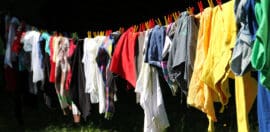Cleaning Up the Energy Game

12 April 2017 at 8:47 am
Adrian Merrick describes himself as “a bit of a frustrated entrepreneur”. But after trying his hand at a number of start-ups including a teddy bear business – “a long story” – a dot-com, and a decade and a half of experience in running energy retail operations, he decided it was time to use his experience to make energy “fairer, cleaner and better value”.
The former group executive manager of retail at EnergyAustralia, launched Energy Locals, one of Australia’s first and only social enterprise energy retailers.
His aim is to see people “get themselves away from the traditional energy grid” and at the same time turn a product that everybody needs, into an innovative way of fundraising for worthwhile causes.
“I’m going to give this a damn good go and see if you can actually operate in this market while genuinely doing the right thing,” Merrick says.
Energy Locals provides businesses with the tools to set up their own energy plan with over half the profits going to charities and creating clean energy.
Customers can choose from a range of local and national organisations to support who will each receive a donation from Energy Locals.
The enterprise also recently launched a product whereby 100 per cent of the profit will be put into new renewable energy.
Merrick told Pro Bono News he just wanted to “have a go at doing something” that was challenging the norm and could be “genuinely positive” for customers.
“I can survive in a corporate environment if I really have to, but it’s probably not the sort of environment that I want to be in for the rest of my life,” he says.
“So often in a big corporate… your main job is to try and talk so much and so loudly about the headline, that no one looks at the small print. And the small print is often really quite damaging, or quite incredulous. And I sort of want to talk about something, and do something, that genuinely helps customers.
“The very first part of my career was actually in an HR role, and an ex-boss of mine said to me I can see your HR background coming out too often because you’re actually too people focused, and that was seen as a negative. And I walked away from that thinking well f*** you, because I’d rather be in a situation where I’m people focused.
“You can still be rational and commercial in that world, but you don’t have to screw customers, that’s not a world in which I really want to be.”
After a year and a half in the pipeline, working through strategies, modelling, planning, and securing initial capital, Energy Locals opened for business in NSW and south east Queensland in January 2017.
“It’s grown from sketch to something that’s real now,” Merrick says.
He says his “end goal” is to see people get themselves away from the traditional energy grid and become self-sufficient for their energy needs.
But he admits that is going to take “a little bit of time”.
“There’s not that many people that are going to want to cut the umbilical cord to the grid over the next few years,” he said.
“But I do predict this will be something that will accelerate in years to come.
“What I think is very viable is people will be operating in self-sufficient micro grids whereby you and a small number of neighbours are essentially an island from the grid, and maybe there is one central connection point to the energy grid, which is much cheaper than all of you having your own individual ones.
“Now all of these things are going to take a lot of changes to the way the industry works, a lot of changes to the regulations, so that’s how I see things going a long way from now.
“So I’m working backwards from that, I’m saying actually how can we take steps towards what that is, which is giving people energy independence and giving them control over the source and the cost of the energy they use.”
Merrick says for decades people were not given a choice over where their energy came from, how it was generated or what it cost.
“They’ve had absolutely zero say in that, and energy companies have grown up to be worth billions and billions of dollars, based on people not having a say,” he says.
“Of course now that’s changed very quickly because people have a say. Some customers have done this [and] taken themselves away from this traditional model and said: ‘well screw you’.
“I actually got a letter once from a customer several years ago who thanked me for a price change letter that I’d sent out, and I thought that’s pretty strange – You don’t get that much fan mail as a big energy company.
“So I was reading it and it had already caught my attention because it had a very polite opening rather than just a bunch of abuse, so that was the first clue that something was wrong. And I kept reading it and he said: ‘Thanks for your price change letter, I’m really pleased that you put your rates up in South Australia to this, because this is the final piece that I needed in my business case to get myself off the grid, f*** you, yours sincerely’. And I was like ‘okay’.”
Merrick says his plan is to offer customers a viable alternative and give them control over the source and cost of the energy that they use.
“Everything that we do has to tick three boxes – it has to be cheaper, it has to be cleaner and it has to be fairer,” he says.
“By fairer we mean no dodgy small print, no nasty service conditions that are designed to lure people in and then have them trapped.
“We’re not always going to be the cheapest option on the market but that’s partly because part of our fairer means that we don’t lure people in with misleading discounts and then screw them later.
“So we have a policy of the price is the price, we retain a fixed service fee before providing the energy and that’s it. We’re not making money from people who use lots of energy. So it’s a very different way.
“And if we can’t save a customer money, we tell them.
“I spoke with a customer last week and he said: ‘Look I’ve been offered these rates by this other company to try and stay around’. And I said: ‘Well they are short term rates.’ And he said: ‘Yeah I get that. And I said: ‘Look they’re going to put up their prices in July… [but] this would cost you about another $15 per month if you were to be with us right now. So why don’t you stay with that offer… I’m pretty sure the other company will have to stretch their prices more than we will in July, so let’s get in touch then, and if we can save you money then great’. Because the last thing we want is people to say ‘yeah that’s great’, and then three months later they get pissed off, because they think they’ve been lured by some sort of marketing.”
Merrick says the enterprise retains a fixed per customer, per month service fee that’s in the region of $12.50 for most customers.
“Anything that is remaining, goes to our partners,” he says.
Some of the inaugural organisations supported by Energy Locals include The People’s Solar, Starlight Children’s Foundation, The Valley Centre and Ronald McDonald House.
“So they are all community focused in some ways, so charities, community organisations, people trying to raise money for Indigenous projects, to replace diesel generators with solar and batteries for example, so people doing good things,” Merrick says.
“In some cases with those organisations some of them came to us and said that’s all very well but we want a bit of certainty over what we earn. So we came up with a couple of product variations that give those organisations fixed income, and we then bare the risk and that’s okay. We’ll see how some of those go.
“If there’s anything left over then it will get invested in new local renewable energy. So not big solar funds that are very investment grade kind of things, but you know community based stuff.
“So that’s the way we’re structuring it. Essentially we’re running a retailer as a service provider, so that people can use us as a different way to fundraise, in many cases because this is something that someone is paying for anyway.
“So, we figure why not put that to good use? But let’s not try to make the same profit as other energy companies and then add a bit on for our partners, let’s actually carve up the profit, so we’re retaining a very small amount, and our net profit is less than $50 per customer per year.”
But he says the model is not without its challenges.
“You can waste a lot of time as a start-up, as I’m sure a lot of people will be familiar with out there, just trying to work out what is the best web-based project management system and what is the best way to manage our company emails and just the admin overhead like that can be such a time drain. So actually there is a whole lot of learnings on that,” he says.
“When I was looking around I just couldn’t find anyone who said: ‘Look if you’re a small company and you just need to do stuff like this, these are the best ones we’ve found, having tried lots of stuff’. I found lots of people doing in depth reviews of lots of project management software, but actually I don’t need that, I just need to know the answer.”
He says another challenge was getting the team on board.
“You take people with different backgrounds… [and] with a mixture of experience and then suddenly you’ve got to have them all in a startup environment. And some people are really well suited to that because they are just go-getters and other people think about things in a more corporate way, and so they think as though they are still in a big organisation,” he says.
“So you’ve got to subtly shift everyone’s mindset, and actually your own, to think just in that mindset.
“People often say you should treat company money like it’s your own, but I should actually treat my own money like it’s the company’s, because we are so stingy in the way we just preserve cash. If we can avoid spending $500 on a designer by fiddling around in Adobe InDesign then we do, because that is $500 that we can put towards our partners and our customers instead.
“Then the other challenge is just getting yourself known.
“We are never going to run TV ads and waste money in that sort of way but you have got to take the slow approach to getting known and that requires patience which I’m not very good at so that’s been a challenge, because you launch and you go ‘great, we should be sorted then, let’s go, where is everyone’ and then you think ‘oh yeah, no one knows about us’.”
But his patience seems to be paying off.
Energy Locals has just teamed up with Surf Life Saving New South Wales to help support lifesaving activities across the state.
Surf Life Saving New South Wales’ chief operating officer Daniel Gaffney says the partnership offers a “unique way” for customers to benefit, whilst also raising new funds for the organisation.
“Fundraising can be a challenge for organisations and it is with the generous contributions from the community that Surf Life Saving New South Wales ensures the iconic red and yellow flags continue to save lives on our beaches,” Gaffney says.
“Each weekend across 129 NSW beaches, the 77,000 volunteer Surf Lifesavers work tirelessly to keep people safe around the water. We hope this new partnership will not only provide a great new utility service to NSW households but also allow us to raise some much needed funds for our frontline services through the generous social enterprise that Energy Locals have established.”
To coincide with the launch of the Surf Life Saving New South Wales partnership, Energy Locals also announced it will lock its prices until 1 July 2018 for both existing and new customers.
“Customers have to fight to get the best deal, we think it’s time to change that,” Merrick says.
“We promise that prices will never be increased to increase profit, and we give customers a way to know that their bills are being put to good use.”







